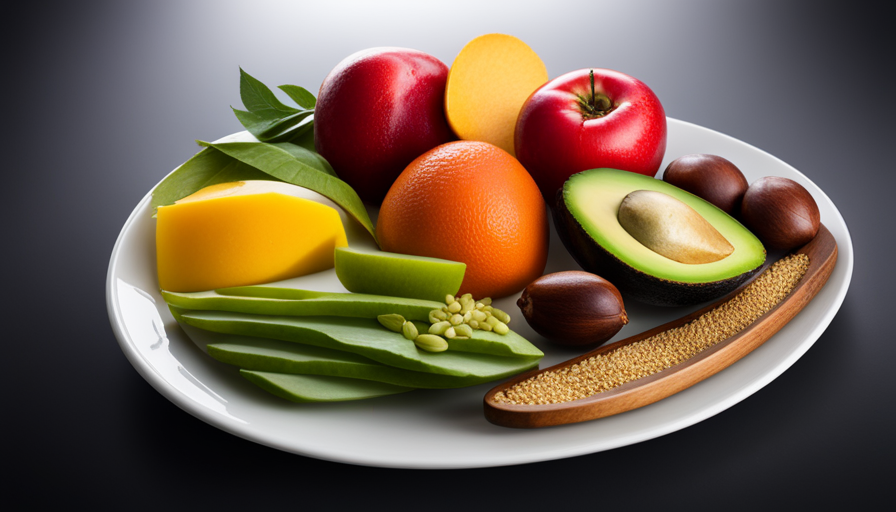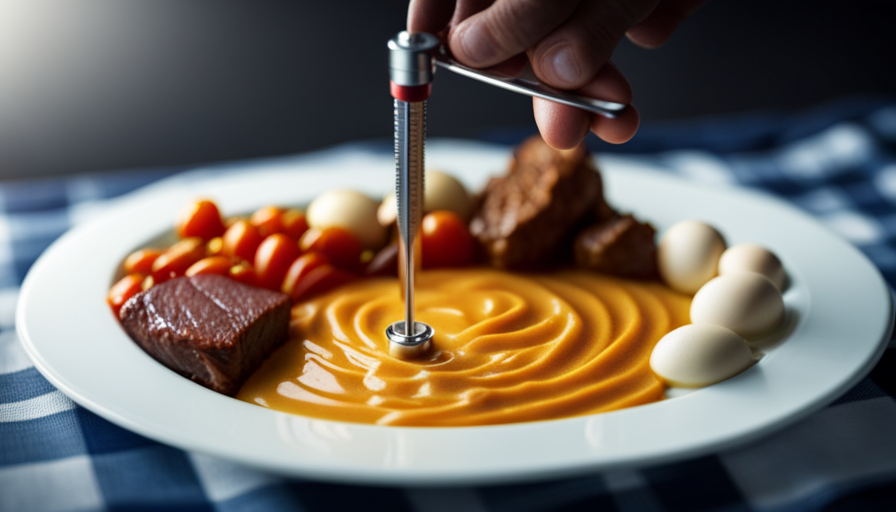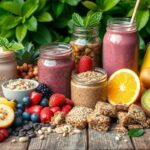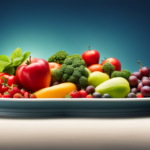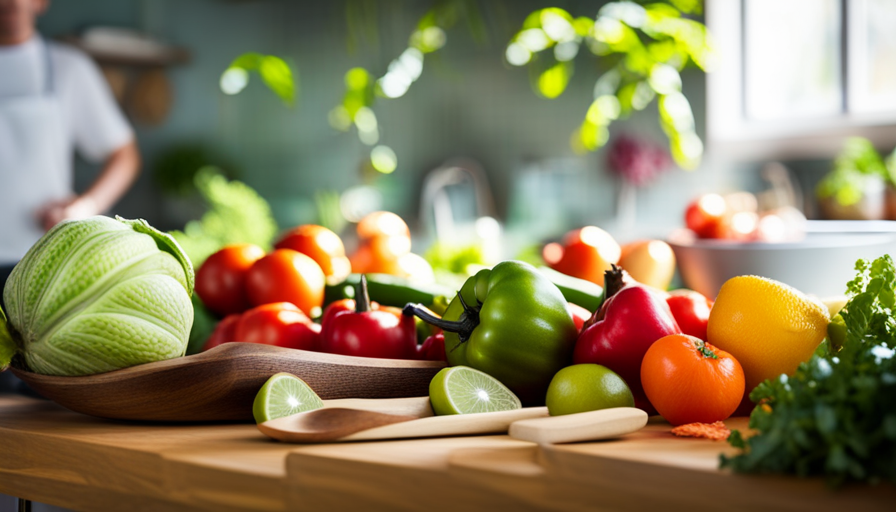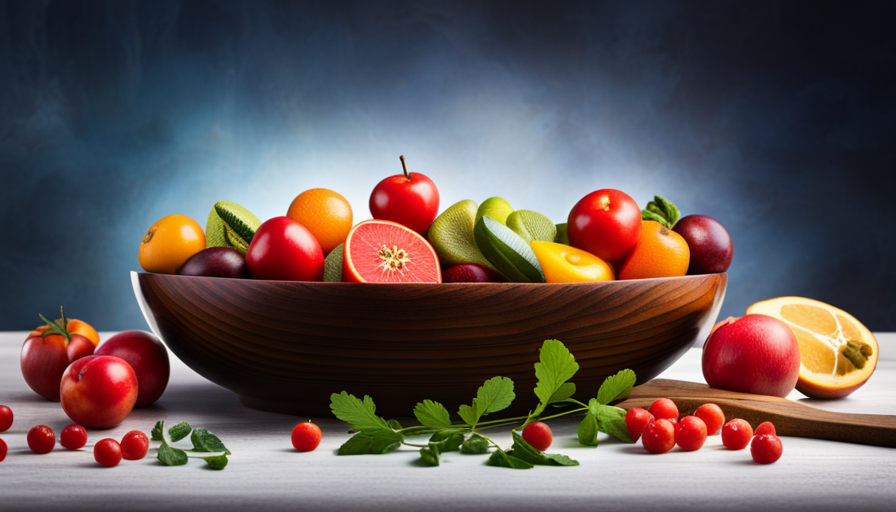Struggling to go from a lean physique to a more robust, satisfying body while following a raw food diet? Look no further! This article provides a plethora of practical tips and tactics to help you gain weight while sticking to your raw food diet principles.
The raw food diet, which emphasizes the consumption of unprocessed and uncooked foods, can be a challenge for those seeking to pack on the pounds. However, with the right knowledge and approach, you can achieve your weight gain goals in a healthy and sustainable way.
From calculating your caloric needs and incorporating calorie-dense foods to adding healthy fats and protein-rich options, we’ve got you covered.
So, grab a pen and paper, get ready to revamp your menu, and embark on a tantalizing journey towards your desired weight on a raw food diet!
Key Takeaways
- Choose nutrient-dense options for optimal nutrition
- Include avocados, nuts, and seeds for healthy fats and essential nutrients
- Balance macronutrients – protein, healthy fats, and carbohydrates
- Portion control is crucial for healthy weight gain
Understanding the Raw Food Diet
Understanding the raw food diet can be challenging at first, but it’s important to delve into the principles and guidelines in order to fully grasp its potential benefits for weight gain.
The raw food diet is based on the idea that eating foods in their natural, unprocessed state provides the body with the highest level of nutrients and enzymes. By consuming primarily fruits, vegetables, nuts, and seeds, you can nourish your body with a wide range of vitamins, minerals, and antioxidants.
One of the main benefits of the raw food diet is its ability to promote weight gain in a healthy manner. Raw foods are generally lower in calories and higher in fiber compared to processed foods, which can help you feel fuller for longer and prevent overeating. Additionally, raw food recipes often incorporate nutrient-dense ingredients that can support muscle growth and energy levels, such as avocado, nuts, and seeds.
To gain weight on a raw food diet, it’s important to focus on consuming a variety of calorie-dense foods. This can include adding healthy fats like coconut oil or nut butters to your meals, incorporating more high-calorie fruits like bananas and dates, and including protein-rich foods like hemp seeds or spirulina. Balancing your macronutrients and ensuring you’re getting enough calories from a wide range of raw food sources is key to gaining weight in a healthy and sustainable way.
Calculating Your Caloric Needs
Calculate your body’s energy requirements like a mathematician solving a puzzle, ensuring you’re fueling your raw lifestyle with the perfect amount of nourishing goodness.
When it comes to gaining weight on a raw food diet, it’s important to understand how many calories your body needs to maintain its current weight and then adjust accordingly. Here are three key steps to help you calculate your caloric needs and track your food consumption:
-
Determine your Basal Metabolic Rate (BMR): This is the number of calories your body needs to function at rest. Use an online BMR calculator, which takes into account your age, gender, height, and weight. This will give you a baseline number to work with.
-
Consider your activity level: If you have an active lifestyle or engage in regular exercise, you’ll need to factor in additional calories to fuel your activities. Use an activity multiplier to estimate how many extra calories you require.
-
Track your food consumption: Keep a food diary to monitor your calorie intake. This will help you identify any gaps in your diet and ensure you’re consuming enough calories to gain weight. Include all the raw foods you eat, along with their respective calorie counts.
By calculating your caloric intake and tracking your food consumption, you can make informed decisions about your diet and ensure you’re providing your body with the necessary fuel to gain weight on a raw food diet.
Incorporating Calorie-Dense Foods
To achieve your desired results, try incorporating more nutrient-rich, calorie-dense options into your meals and snacks. One way to do this is by making high-calorie smoothies. Smoothies can be a great way to pack in extra calories while still getting a variety of nutrients.
Start by using a base of fruits and vegetables, such as bananas, avocados, or leafy greens. Then, add in high-calorie ingredients like nut butters, seeds, or coconut oil. These additions not only increase the calorie content of your smoothie but also provide essential healthy fats and proteins.
Another way to boost your calorie intake on a raw food diet is by incorporating nuts and seeds into your meals. Nuts and seeds are calorie-dense and offer a good balance of healthy fats, proteins, and fiber. You can sprinkle them onto salads, blend them into dressings or sauces, or simply snack on them throughout the day. Some great options include almonds, walnuts, chia seeds, and flaxseeds.
Remember, while it’s important to increase your calorie intake, it’s equally important to focus on nutrient-rich options. So, make sure to choose whole, unprocessed foods that provide a range of vitamins, minerals, and antioxidants.
By incorporating high-calorie smoothies and nuts/seeds into your raw food diet, you can effectively boost your calorie intake and achieve your weight gain goals.
Adding Healthy Fats to Your Meals
Boost the flavor and nutritional value of your meals by incorporating healthy fats such as avocado, olive oil, or coconut milk. Here are four healthy fat sources for weight gain on a raw food diet:
-
Avocados: Avocados are rich in monounsaturated fats, which can help increase your calorie intake. They’re also packed with essential nutrients like potassium, vitamin K, and vitamin E. Add sliced avocados to your salads, blend them into smoothies, or spread them on raw crackers for a delicious and nutritious snack.
-
Nuts and seeds: Nuts and seeds are great sources of healthy fats and protein. They’re also high in calories and provide essential nutrients like magnesium and omega-3 fatty acids. Enjoy a handful of raw almonds, walnuts, or chia seeds as a snack or sprinkle them on top of your raw food dishes for added crunch and flavor.
-
Olive oil: Olive oil is a staple in Mediterranean cuisine and is known for its heart-healthy benefits. It’s rich in monounsaturated fats and antioxidants, which can support weight gain and overall health. Use it as a dressing for your salads or drizzle it over your raw vegetables for a flavorful boost.
-
Coconut milk: Coconut milk is a creamy and delicious addition to your raw food meals. It’s high in medium-chain triglycerides (MCTs), which are easily digested and can be used as a source of energy. Use coconut milk in smoothies, soups, or desserts to add a rich and satisfying texture.
Incorporating these healthy fats into your raw food meals can not only help you gain weight but also provide essential nutrients for optimal health. So go ahead and experiment with avocados, nuts, olive oil, and coconut milk to add flavor, texture, and nourishment to your diet.
Including Protein-Rich Foods
Including protein-rich foods in your meals can give your body the strength and energy it needs to thrive, leaving you feeling satisfied and ready to take on the world. When following a raw food diet, it’s important to ensure you’re getting enough protein to support your weight gain goals.
Fortunately, there are plenty of plant-based protein sources available to choose from. Some excellent protein sources on a raw food diet include nuts and seeds, such as almonds, walnuts, and chia seeds. These’re not only packed with protein but also provide healthy fats and fiber. Another great option is legumes, like lentils and chickpeas, which can be sprouted and enjoyed raw. They offer a good amount of protein and’re versatile in various dishes.
While including protein-rich foods in your meals is essential, it’s also important to practice portion control. Even though these foods’re healthy, consuming too much can lead to excess calories and potential weight gain. Aim for a balanced approach and include a variety of protein sources in your meals, along with plenty of fruits and vegetables.
Remember, it’s always a good idea to consult with a healthcare professional or registered dietitian before making any significant changes to your diet. They can provide personalized guidance and ensure you’re meeting your nutritional needs while gaining weight on a raw food diet.
Choosing Nutrient-Dense Options
One way to ensure optimal nutrition is by selecting nutrient-dense options that are packed with essential vitamins and minerals. When following a raw food diet to gain weight, it’s important to choose foods that provide a high calorie content while still being nutrient rich. Here are some options to consider:
-
Avocados: These creamy fruits are not only high in healthy fats, but they also contain essential nutrients like potassium, vitamin K, and vitamin E.
-
Nuts and seeds: Almonds, walnuts, chia seeds, and flaxseeds are excellent sources of healthy fats, protein, and fiber. They can be added to smoothies, salads, or eaten as a snack.
-
Coconut: Coconut meat, milk, and oil are all rich in healthy fats and calories. They can be used in various raw food recipes or enjoyed on their own.
-
Dried fruits: Dates, raisins, figs, and prunes are all concentrated sources of natural sugars and calories. They can be used as sweeteners in desserts or added to trail mixes for an extra energy boost.
-
Nut butters: Peanut butter, almond butter, and cashew butter are all excellent sources of healthy fats and protein. They can be spread on fruit slices or used as a dip for vegetables.
By incorporating these nutrient-dense options and finding high calorie fruits into your raw food diet, you can ensure that you’re getting the necessary calories and nutrients to support weight gain in a healthy and sustainable way. Remember to listen to your body and make adjustments as needed.
Balancing Your Macronutrients
To ensure a well-rounded and balanced diet, it’s crucial for you to strike a harmonious balance between the three macronutrients: protein, healthy fats, and carbohydrates. Understanding macronutrients is key to gaining weight on a raw food diet.
While carbohydrates provide energy, protein and healthy fats are equally important for muscle growth and overall health. Remember the saying ‘you can’t have your cake and eat it too’ as a reminder to prioritize all three macronutrients.
Protein is essential for building and repairing tissues, and it can be obtained from plant-based sources such as legumes, nuts, and seeds. Incorporating a variety of these foods into your diet will ensure you are getting a sufficient amount of protein.
Healthy fats, found in avocados, coconut oil, and nuts, are important for hormone production and nutrient absorption. Including these fats in your meals can help increase your caloric intake.
Portion control is also crucial when trying to gain weight on a raw food diet. While it’s important to consume enough calories, eating excessively can lead to weight gain in an unhealthy way. Pay attention to your body’s hunger and fullness cues and make sure to eat balanced meals with appropriate portions.
Gaining weight on a raw food diet requires a balanced approach that includes all three macronutrients – protein, healthy fats, and carbohydrates – in appropriate portions. By understanding macronutrients and practicing portion control, you can achieve your weight gain goals while maintaining a healthy lifestyle.
Meal Planning for Weight Gain
Looking to bulk up? Let’s talk about how you can strategically plan your meals to achieve your desired results.
When it comes to gaining weight on a raw food diet, meal planning and portion control are key.
First, meal prep is essential for success. Take some time each week to plan and prepare your meals in advance. This will ensure that you have healthy, calorie-dense options readily available. Include a variety of fruits, vegetables, nuts, seeds, and whole grains in your meal prep to ensure a balanced intake of macronutrients.
Next, portion control is important to consider. While it’s important to consume enough calories to support weight gain, it’s also crucial not to overeat. Start by calculating your daily calorie needs and aim to consume slightly more than that to create a calorie surplus. This surplus will promote weight gain over time.
When it comes to portion sizes, listen to your body and eat until you feel satisfied, but not overly full. Focus on nutrient-dense foods that are rich in healthy fats and protein, as these will help promote muscle growth. Be mindful of portion sizes and adjust as needed to meet your individual goals.
With a well-planned meal prep and portion control, you can successfully gain weight on a raw food diet.
Staying Consistent with Your Eating Habits
Maintaining consistency with your eating habits can be challenging, especially when cravings for unhealthy options arise. However, staying motivated and overcoming these challenges is crucial for gaining weight on a raw food diet. Here are some tips to help you stay on track:
-
Plan ahead: Preparing your meals in advance can help you avoid impulsive food choices. Create a weekly meal plan and make sure to include a variety of raw foods that are high in calories, such as nuts, seeds, avocados, and coconut.
-
Find healthy alternatives: Instead of reaching for processed snacks or sugary treats, try satisfying your cravings with healthier options. For example, if you’re craving something sweet, opt for a piece of fruit or a homemade raw dessert.
-
Surround yourself with support: Having a strong support system can help you stay motivated and accountable. Join an online community or find a raw food diet buddy who can share tips, recipes, and encouragement.
-
Practice mindfulness: Pay attention to your body’s hunger and fullness cues. Eat when you’re hungry and stop when you’re satisfied. This can help prevent overeating and promote a balanced approach to weight gain.
By staying consistent with your eating habits and implementing these strategies, you can overcome challenges and successfully gain weight on a raw food diet. Remember to listen to your body and make choices that nourish and support your goals.
Consulting with a Nutritionist or Dietitian
Consulting with a nutritionist or dietitian can provide expert guidance and personalized recommendations to optimize your eating habits and achieve your health goals. These professionals have a deep understanding of the science of nutrition and can help you navigate the complexities of a raw food diet.
One of the main benefits of working with a nutritionist is that they can assess your current eating habits and identify any nutritional gaps or deficiencies. They can then provide recommendations on how to fill those gaps and ensure that you’re getting all the necessary nutrients to support healthy weight gain. They can also help you create a balanced meal plan that includes a variety of raw foods to meet your caloric needs.
Finding a qualified nutritionist or dietitian is crucial. Look for professionals who have the appropriate credentials, such as a Registered Dietitian (RD) or Certified Nutrition Specialist (CNS). You can also ask for recommendations from your healthcare provider or do some research online to find reputable professionals in your area.
When consulting with a nutritionist, be prepared to share your goals, preferences, and any specific dietary restrictions you may have. This’ll help them tailor their recommendations to your individual needs. Remember, a nutritionist can be a valuable resource in your journey to gaining weight on a raw food diet.
Frequently Asked Questions
Can I gain weight on a raw food diet without consuming calorie-dense foods?
Yes, it’s possible to gain weight on a raw food diet without consuming calorie-dense foods.
Alternative ways to gain weight on a raw food diet include increasing your intake of nutrient-dense foods like avocados, nuts, seeds, and coconut oil. These foods provide healthy fats and calories that can help you gain muscle mass.
Additionally, incorporating protein-rich foods such as legumes, tempeh, and tofu can support muscle growth.
Remember to listen to your body and consult with a healthcare professional or registered dietitian for personalized advice.
How can I ensure that I am getting enough protein on a raw food diet?
To ensure you’re getting enough protein on a raw food diet, focus on incorporating protein-rich sources such as nuts, seeds, legumes, and leafy greens into your meals. Almonds, chia seeds, lentils, and spinach are excellent options. Additionally, sprouting seeds and legumes can increase their protein content.
Remember to vary your protein sources to get a wide range of amino acids. Consult a registered dietitian for personalized advice and more raw food diet weight gain tips.
Are there any specific nutrient-dense foods that are particularly beneficial for weight gain on a raw food diet?
To promote weight gain on a raw food diet, incorporating nutrient-dense fruits is essential. Fruits like bananas, avocados, and dates are rich in healthy fats and calories, which can help increase your calorie intake and support weight gain.
Additionally, including nuts and seeds in your diet can provide protein and healthy fats. However, it’s important to remember that weight gain strategies should be balanced and personalized to your specific needs and goals.
Can I still achieve weight gain on a raw food diet if I have specific dietary restrictions or allergies?
Oh, you thought that having specific dietary restrictions or allergies would make it impossible to gain weight on a raw food diet? Well, think again!
While it may seem challenging, with careful planning and a variety of nutrient-dense options, you can still achieve weight gain on a raw food diet. By focusing on foods that meet your dietary needs and avoiding allergens, you can nourish your body and support healthy weight gain while enjoying the benefits of a raw food lifestyle.
How long does it typically take to see noticeable weight gain results on a raw food diet?
Typically, it takes time to see noticeable weight gain results on a raw food diet. The rate at which you gain weight can vary depending on various factors such as your metabolism, activity level, and calorie intake. It’s important to focus on consuming a sufficient number of calories from a variety of nutrient-dense raw foods to maintain weight on a raw food diet. Additionally, incorporating healthy fats and protein sources can help support weight maintenance.
Can a Raw Food Diet Help with Weight Gain as Well as Clear Skin?
A raw food diet can contribute to weight gain due to the high calorie and healthy fat content in certain raw foods. Additionally, the vitamins and antioxidants found in raw fruits and vegetables can help promote clear skin with raw food by reducing inflammation and promoting overall skin health.
Conclusion
In conclusion, if you’re looking to pack on pounds while following a raw food diet, it’s important to focus on incorporating calorie-dense foods, healthy fats, and protein-rich foods into your meals.
Balancing your macronutrients and meal planning can also help you achieve your weight gain goals.
Remember to stay consistent with your eating habits and consider consulting with a nutritionist or dietitian for personalized guidance.
By following these tips, you can embark on a weight gain journey that’s both nourishing and satisfying.

